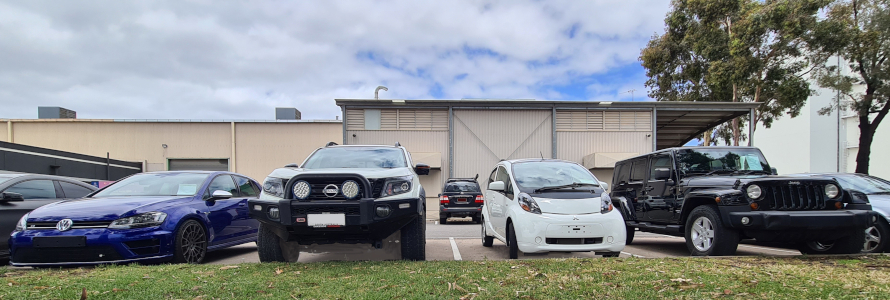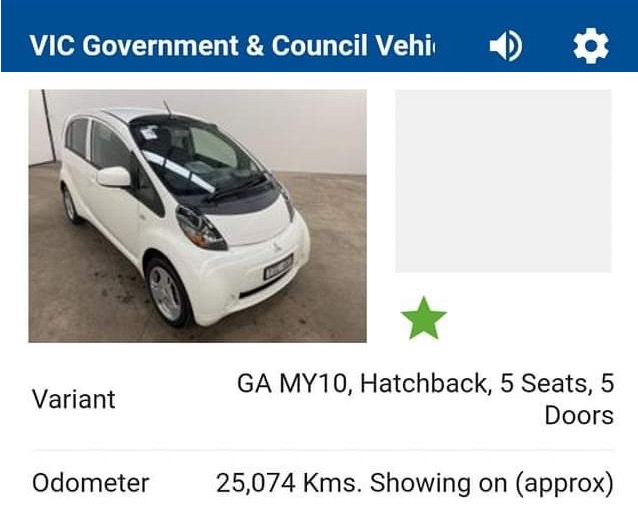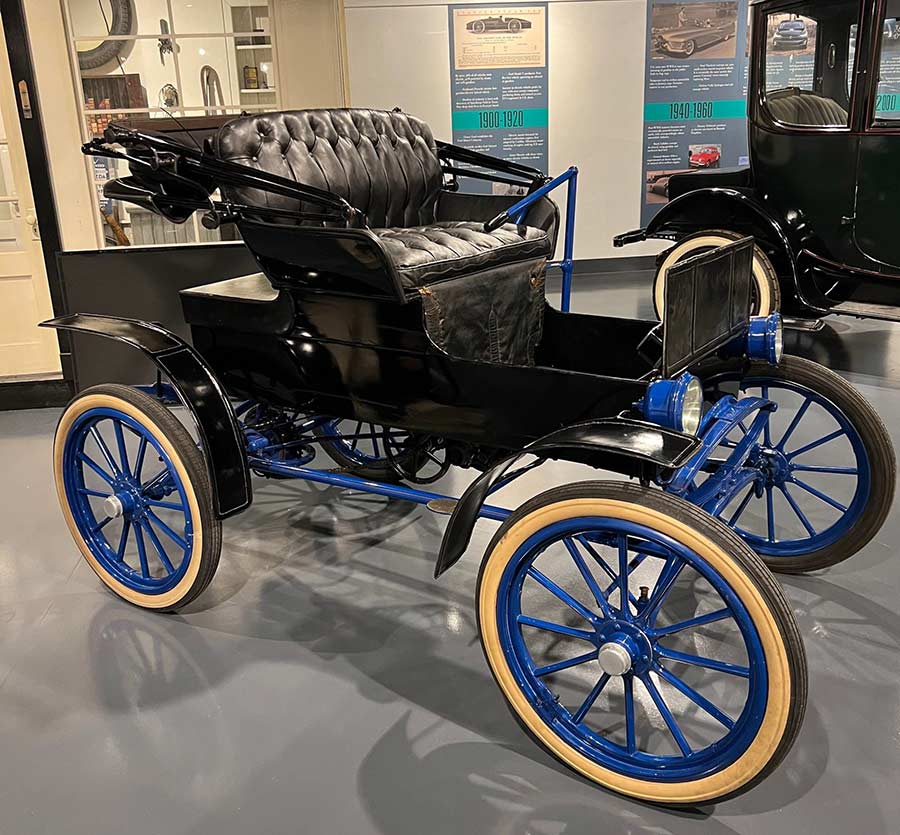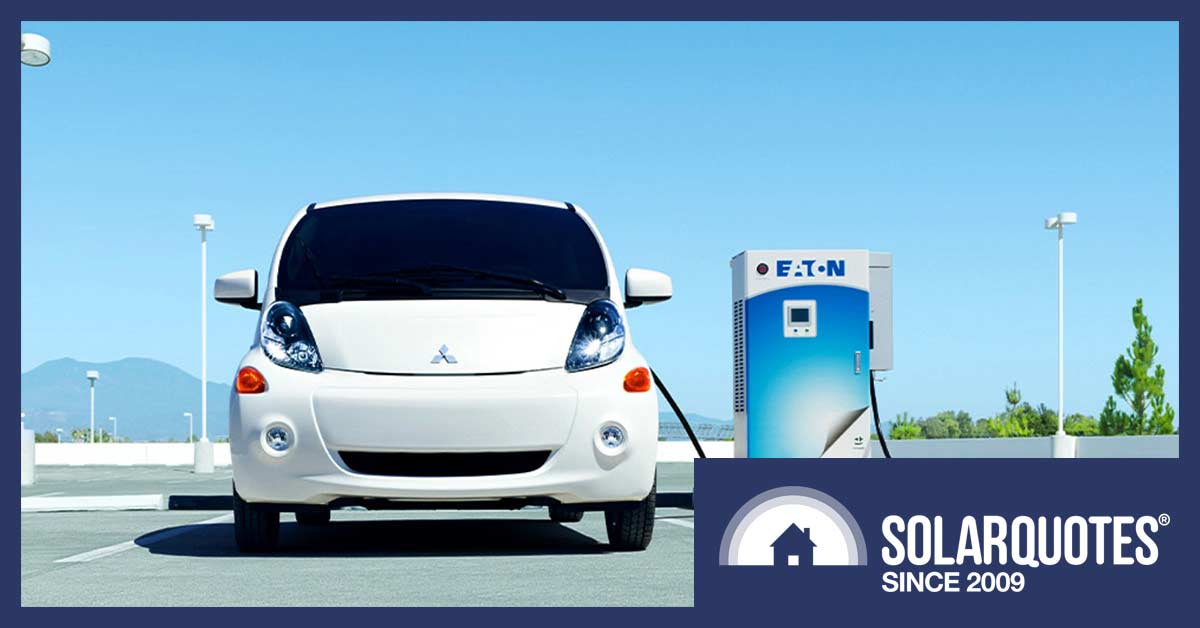Trawling the internet the other day, I saw an article proclaiming Australia’s cheapest electric vehicle is a 10-year-old Mitsubishi i-MiEV. The headline struck me in particular – because I bought it.
Actually, I bought the sister car of this i-MiEV from the same dealer: 25,000 km on the clock for a somewhat ludicrous seventeen grand plus rego.
The i-MiEV is diminutive enough that I can drive it through just one of the double gates at home, and of course, just like the original Mini, it makes everything else in the car park look like a totally unnecessary behemoth. Especially the horribly compromised, hopelessly heavy, dual cab 4wd grocery getters.

It’s not just the easy parking, note the size of the tyres.
I could wax on with the numbers motoring geeks love: 180 Nm of torque might be a bit abstract, but let’s just sum that up as ‘fun’ in an electric car barely weighing a ton.
How Much Power?
If you mash the accelerator to the floor, the iMiev motor will deliver a peak output of 47 kilowatts.
In car terms, that’s pretty modest. A Nissan Navara pictured above has three times the power. A prime mover has 10 times as much power, with torque that would twist the iMiev like a damp tea towel.
Now compare that to an average household. The electricity service from the street delivers 230v x 63amps = 14.5 kilowatts. Your average 6.6 kW solar power system on the roof will, at best, deliver 5 kilowatts.
How Much Energy Storage?
Home batteries start at about 6.5 kilowatt hours, the Tesla Powerwall is around 13 kilowatt hours and a typical off-grid house needs two or three times more.
The “fuel tank” in the iMiev is a battery with 16 kilowatt hours capacity. Again, it’s pretty modest compared to other electric vehicles such as a new Nissan Leaf with 60 kilowatt hours; or a flagship model Tesla with 100 kilowatt hours.
So why am I highlighting the hours?
When you plug an electric car in with a 7.5 kilowatt EV charger, it will be a significant demand on the overall capacity of your grid connection. Unlike cooking eggs or making toast, charging goes on for hours on end. This is why it’s important, when you consider solar power in the future, to install as much as you can.
Comparing to the Navara, a rough calculation puts 70 litres of diesel at 767 kWh, but burning it in your Navara at 20% efficiency only yields 153 kWh. But at least we don’t have to buy kilowatt hours for EVs from extremist theocracies overseas.
Doing My Research
Like every niche interest there is of course a social media following. And in many cases, they’re a priceless resource. When the two iMievs popped up I jumped on one, because the last couple of these rockets that surfaced in Adelaide went fairly quickly for $12-14 grand.
Through the same group, I winced as I discovered the EVs came from a government auction for a bit over $10 grand each. At that price, you could sell dozens.

For $10,200 this was a bargain.
With more than a passing interest in things automotive, I’m used to classic cars that go up in value. Almost anything with a chrome bumper commands a premium these days (except a Galant Wagon).
So, while you can rationalise the Mitsubishi iMiev as a classic because they’re the first mass-produced EV of the modern era, they’re equally just unknown and unloved used cars that are defying gravity by appreciating; because they’re electric.
Like many iMievs owned by public authorities or early adopters, these two have led a fairly leisurely life. But we’d best leave the jokes about sheltered workshops alone as I wouldn’t want to throw shade on the iMiev. The dealer enthused about the comprehensive service history, and I burst his bubble a bit by observing they must have checked the lights and wipers each year. As it turns out, they didn’t check the tyres because I had to pump them up myself.
Public service announcement
Tyre pressure matters. If you’re in doubt, pump them up because if you make an error, more is better than less.
Why Didn’t I Get One Earlier?
When the i-MiEV was launched, I’m told you could only lease them. In 2010 that was $1,740 a month over a three-year term. Interestingly the government inspector who checked my vehicle ID last week remembered they had some shopped around a few departments, but he wasn’t allowed to have an i-MiEV.
This is a case in point as to why we should retain public ownership of utilities. I could never afford the $62,000 lease or $48,000 new-car-price, but government fleet buying power can put new EV technology into the second-hand market for normal people to buy.
Now demand is rising, people are importing EVs privately. Organisations such as The Good Car Co. have been bringing in the ever-popular Nissan Leaf from Japan, while some of the “performance” car importers are happy to co-ordinate other electric vehicles such as the iMiev’s boxier brother, the Minicab van. The last one of those I saw for sale here was wrapped in pink vinyl and commanding $20 grand… but at least you could sleep inside it, unlike a dual cab ute.
See exhibit A :

You could buy an iMiev van for each day of the week and still have enough for a house deposit… or you could have this garden shed with diamond stitch seats and no bed.
What Have I Learnt In The First Week?
- DO NOT LOOK AT CARSALES. Seriously, after months of nil listings, there will be another two turn up that are much cheaper. I’m clinging to the fact mine is the lowest mileage I’ve ever seen.
- Don’t leave the interior light on. If the 12-volt “car” battery is flat, then nothing works – despite the traction battery being charged.
- The headlights are quite good. I’m a student of car lights and have a visceral reaction to those horrible illegal drop in LED replacements.
- Range is low: In mixed traffic, reasonably flat terrain, some 110 kph highway cruising and air conditioning, 75 km was a comfortable range for my i-MiEV. Bear in mind the original data for the car claimed 100 or 155 km depending on whose standard you applied.
- Range can be extended: Local legend Graeme Manietta in Brisbane has launched the i-MiEV battery upgrade to get over 240 km of real-world motoring. That’s double the original range, which is great for the cars still running around.
- Peugeot and Citroen sold them in Europe badged as the iOn and C-Zero respectively… and i-MiEV’s are cheap there.
- They’re selling in the USA right now, used, for comparable sums to ours.
- Only 250 odd units came to Australia, and the earlier i-MiEV had an infotainment screen, keyless entry and nicer-looking wheels.
- The tyres are pretty weird sizes, (like a space saver spare that it doesn’t actually have) so despite the slight impact on range, changing wheels might be on the agenda.
Stand By For Updates
I haven’t been washing the i-MiEV twice a week like my Dad does when he gets a new car, but there’s probably enough enthusiasm to keep you posted on what it’s like to live with a “vintage” electric car. So far, it’s proven its worth and if the boss will give me the day off, I’ll load the generator on board and see just how far it goes before I have to make my own petrol powered electric car meme.
I lament I missed out on the first EV I really wanted. We think it’s a 1906 Baker electric and $35,000 AUD would almost have bought it, plus freight and taxes. I would have loved to see how this goes as a restored car. However, I would swap the ~150 kg lead acid battery for modern chemistry to see how much difference that makes to its range.

Baker Electric c.1906 20 volt motor included. On a US site for $20k USD. Not much to work with? Actually, there wasn’t much in the first place. The motor is in that blue tub.
These Edwardian-era electrics were quite popular but hamstrung by the lack of electricity outside the city. It seems charging infrastructure has always been an issue, just as water availability limited the range of steam cars.
The early days of infernal combustion engines, though plagued with unreliable ignitions and mechanical failure, were made practical by fuel transported in four-gallon tins packed in pairs in a timber box, and hauled by horses to your nearest chemist shop or blacksmith.

A real horseless carriage. Iimage: Bill Lillie
For now, you too can have a 2011 Mitsubishi i-MiEV priced at $17,990 drive-away with just a tad over 32,000km on the clock. Listed in late November, John Raffaele is standing pretty firm on his price because some mug already paid much the same for a white one he had. Sorry.


 RSS - Posts
RSS - Posts



Keep it coming Anthony, much appreciate your research and insight.
I’m looking out for a hybrid (so I don’t have to carry a spare generator as well as a spare tyre to get from Northam to Bridgetown (both in WA)).
Something that can be adapted if not already V2H as I have the 6k66W PVA and 5kW 3ph hybrid inverter – battery ready.
Was focussing on the Nissan Leaf2 but gone off the idea of all electric.
Just out of interest, what is the energy equivalent for my 90L autogas tank on my 80 series GXL wagon in kWh ?
With the new FBT legislation (novated lease/salary sacrifice) you could have a Tesla Model Y for around $440 a fortnight (over 5 years)… plenty of range and Tesla chargers to get you around WA. Check out TOCWA (Tesla Owners Club WA) on facebook.
Keep it coming Anthony, much appreciate your research and insight.
I’m looking out for a hybrid (so I don’t have to carry a spare generator as well as a spare tyre to get from Northam to Bridgetown (both in WA)).
Something that can be adapted if not already V2H as I have gone off the idea of all electric.
Just out of interest, what is the energy equivalent for my 90L autogas tank on my 80 series GXL wagon in kWh ?
Hi, lucky you and your imev. I also went down a similar path but never finished. I was looking at a 10 year old Leaf. Prices were ~15k with a range of 50-100 kms. The batteries were somewhat used or worn, mileage ~50km-100km. Not a lot of choice though. Original range was about 180 kms on about a 20kWhr battery pack. Replacement cost with genuine parts and dealer labour ~$12,000. Obviously a 30-60kWhr battery pack would be better. I saw a youtube video of a 60kWhr battery pack upgrade, new mounts needed and replacement of rear springs needed. All good to know. But a no deal for me at this time.
In April I imported a 2016 30kWh Leaf Aero (top of the range with bodykit etc) for $20k on the road. 24kWh Leafs were $15k at the time, so the extra $5k was much better value.
I looked at 2nd hand MiEV’s too, but even at $12k they weren’t worth it for just 80km of range. My Leaf get’s about 170km.
I think the author of this article spent WAY too much to be honest.
So a 10 year old ev, you forgot to mention the battery replacement costs or range degradation on this
Hi Ian,
Range is somewhere between 50% and 75% depending on who’s mileage standard you believe was correct when it was new. In the real world it does what I need it to and as I have linked in the original article, battery upgrades are $13k and offer around double the original performance. I actually think that EVs being updated with a new battery, in the same way that enthusiasts like to transplant classic cars with modern fuel injected engines, (and electric power plants now) makes perfectly good sense in terms of saving invested energy and improving environmental outcomes.
Cheers
we are driving one now since 2017. it has all the modern features of an electric car, tire pressure sensors, electric windows, AC.
there has been a series made in japan (right hand drive) equipped with litium titanate batteries (LTO) from toshiba. try to import these, they go forever. the only thing that needs greasing is the cable operating the forward/reverse. I have two charge cables, the original charging at 7A, and one from aliespress charging at 14A, so I can choose depending on the weather en my excess solar power.
I agree that all public services should be in government hands, and run for the benefit of the citizens, not sold into private hands to make money for shareholders.
Otherwise, utility bills will always remain the highest possible that demand will allow. There’s little competition between utilities, so only in government hands can fair prices be maintained.
Governments sell assets that are natural monopolies and it is just transfer of said monopoly.
Services in government hands seems to run like in house monopolies. If you try to bring in private sector managers and increase productivity you get all kinds of push back.
If you think about roof top solar. Basically home owners bring the investment (land, roof mount, purchase the system) and solar into the grid is basically free (paid feed in but zero investment so any profit is massive margin). Home batteries are too expensive but grid level storage makes sense as there is arbitrage profit.
Maybe Dan in Victoria might be onto something but we’ll see.
Can we please stop this 230V nonsense; it’s 240V, as it always was.
‘230V’ was just a paper ruse to placate EU mandarins in Brussels.
If you don’t believe, go and measure it!
Euan MacKenzie
Euan,
Australia is moving to 230V. Because we use transformers (instead of Inverter technology as used in Europe), many homes still show 240v (which is in spec for 230v upper limit). What this does is reduce the inverter voltage overhead which causes more dropouts for inverters.
Anthony, re the Imiev, ours has 120000Km+. Range now abt 80Km, but this is country driving. Front tyres are not easy to find, & bcos ours is used on country roads, our rims have suffered a beating.
One thing to watch is the plastic undertray (we made an Aluminium one). If it is missing, the AC compressor electronics get water ingress. Mine is on the second failure (I fix it myself). This time I made a new lid with Surfboard Cortex ´valves´, that allow the vapour to escape (hopefully!). If the undertray is missing or damaged, the spray reaches the compressor (which is below the 12v battery). The compressor runs on the HIgh voltage of the main battery (so remove the link under the LH seat before any investigation attempted). Also, keep the tyre pressures high (38>40psi).
The Imievs are a tiny rocket! I had a commodore almost lose it trying to follow me through some windies. A local Dr used to say he took his Home-built Lotus 7 copy thru the same road @ 75Kph: never told him the imiev did the same!
There is a lot of info on repairing & running the Imiev on the web.
AC charging maximum is 15A (They will fully charge overnight, but watch the plugs: they get warm! If plugged in to a vertical (wall) pp, support the cable so no stress is on the plug. Best have an industrial 15A socket with the screw ring, if you are running a new cct.
There were V2G inverters avail in Japan. Runs off the Chademo. Never able to source one.
Enjoy!
Hi Doug,
Glad to hear you’re having a good run with the iMiev and thanks for the tech advice. There is of course a few forums & social media sites but if you’re scratching for tyres I do know a bloke with a good solution that involves some wheels from a Yaris. I will round up the details but it involves cheaper and wider tyres. I’m sure the car handles much better as a result.
Cheers
Anthony,
you need to keep the narrow front tyres. The power steering will not tolerate wider tyres. Also wider tyres=more drag, so less range!
I am looking at some rims from the spacesaver wheels, & get the centres changed. The wider fronts are not needed: these things handle well anyway!
The rears can be something like early MX5 rims. Stud spacing is easy. Narrow front alloys hard.
regards, Doug
Seriously only a 75 klm range and with used batteries ? That wouldn’t even get me to work and back. And if you want the i-Miev battery upgrade I notice it is around $13K – no wonder you glossed over the cost part !
Wake me up again in 10 years when people are actually getting value for money in EV purchases. Kermit may have to be totally reen but doesn’t mean I do !
…”green”…damn frogs in my keyboard…
I think my 2016 30kWh Leaf Aero for $20k on the road here was decent value. 170km range. Top spec.
The cheaper hatch-backs are coming early 2023 though…. MG4 ($40k), BYD Dolphin ($40k), Cupra Born ($60k…. not so cheap, but a big 77kWh battery)
Spot on , When EV start to get minimum of 600km range will Australians start to think about buying . I will never buy one as when I drive to Melbourne {from Sydney ] do I not want to sit around for an hour for recharge . For all those saying yes but stop revive survive , We have 2 drivers , so we swap over after 5 minutes of refuelling with normal petrol and continue on our journey
I understand wanting a 600 km range EV in your situation, but I’ll mention the Hyundai Ioniq 5 can get 100 km range in 5 minutes of charging. While having to spend perhaps 20 minutes charging isn’t ideal when you consider the savings in fuel costs it may be well worthwhile.
But we will need more ultra-rapid chargers. I definitely recommend they are available in the right locations for you.
” When EV start to get minimum of 600km range will Australians start to think about buying”
So… no one in Australia has thought about buying a Nissan Leaf…?
Dale , I looked up. Nissan .com.au Leaf 270km range or dearer model 385km range
I have absolutely no idea why you think this is a meaningful response to my question.
Adam – there will always be edge cases where EVs are not appropriate but please don’t assume that your particular scenario represents “Australians”. The facts are that 95% of Aussies don’t need 600kms of range (and BTW there are already EVs that fill that niche – they just cost mo’ money) – on average we drive about 35kms a day or 255kms a week, so most EVs will comfortably cover that with a weekly charge. My Model 3 RWD will do 400kms plus on the freeway, so most Aussies would be perfectly happy to take a short break after 4 hours of driving. Most would need to.
So do they work for everyone? No. You can’t realistically tow a big caravan with an EV (not that they lack the power- just the range). If charging at home is not possible then owning an EV is going to require a very organised approach. If you regularly commute very long distances (ie Sydney to Melb) then an EV might not be for you (depends how regular). If you love the sound of a V8 and don’t mind the cost of petrol, well an EV might not be for you. That’s fine. But we certainly don’t need some arbitrary figure of 600kms – you may do, I don’t.
Hi Reg,
So far this thing is doing exactly what I need it to and I haven’t tested it’s maximum range yet. My diesel ute uses around $12.80 for a 67km weekly trip to see family, 9kWh of electricity is just $3.15, so I’m calling that good value. As for the battery upgrade, I don’t need one yet. Having worked in an engine shop machining parts to tolerances under .001″ I’m well aware that reconditioning an engine is no small investment. It took me hours of hand porting of cylinder heads and a lot more than $13k to double the ‘orsepower of my project car, and in the process I’ve probably halved the fuel mileage.
I actually think that EVs being updated with a new battery, in the same way that enthusiasts like to transplant classic cars with modern fuel injected engines, makes perfectly good sense in terms of saving invested energy and improving environmental outcomes.
Considering the average Australian commute is under 20km you would be an outlier in statistical and geographical terms if you can’t make a return journey on 75km range. If you have a standard 10amp power point available at your work then the iMiev would likely be a good fit, but to be honest I have done long daily commutes and I find spending more than two hours per day in the car isn’t just a waste of tyres, it’s a waste of your life. Your mileage may vary of course.
Cheers
I have the exact same Imiev and even the same colour.
I worked at Mitsubishi head office when we were leasing them since we found out we could not sell them for $65k for 4 seater car. Careful with the tyres as when I replaced them, I lost 20km from my range. And I only had 100km to start with!
The Holden volt is another cheaper alternative for inner city driving with 50km or so of range and petrol generator on board if you need to go further if not you just use the battery and it charges from a 10amp plug. But like your Mitsubishi they are limited numbers and holding good value.
Well done on the exciting purchase. We got similar age/km a little cheaper about 6 months ago, and have have done 5500km in it. Our effective range is more like 70km, but 2 days commuting is fine. There are free charging points close to my work, otherwise I charge at home mostly when sun is shining on our PV. We will look into upgrading the battery probably before winter next year (the cold has more effect than the heat for us). While not cheap, Im happy to invest in this great car, its comfortable and fun to drive.
Thanks Matt,
It does seem to be a good thing. Air conditioning works well, even the seat is pretty comfortable in standard trim. Just needs more cup holders!
To all the EV doubters, recently we travelled Noth coast, NSW to Dubbo via Sydney & return. abt 1000Km each way. Full charge when we left home (400Km+ at hwy speeds in our 64Kw Kona) First charge Port Macq (50Min charge), then Karuah (30Min), then Sydney. Charged at Olympic Pk (1Hr) late at night (busy charger!) Then Lithgow (45Min), then Dubbo (1Hr+), Lithgow, Sydney, Karuah,
Port Macq, Coffs, then home. We find the 750Km trip to Sydney is about an hour longer than with our old Dino car. MUCH cheaper. We do need to stop anyway for rests & meals. Usually we plan our trip around meals, rests, & reading books. We are not in a hurry. I usually sit on 100>105 on the Hwy. 110 uses more energy!
Would not swap back to a Dino car! Leave them for the Fred Flintstones!
Happy NY!